ABSTRACT
Effects of air thawing (AT), refrigerator thawing (RT), water immersing thawing (WIT), lotic water thawing (LWT), and microwave thawing (MT) on the quality of swimming crab by liquid nitrogen freezing were investigated. The highest thawing loss was recorded for MT sample (2.70%) followed by AT (2.22%), WIT (1.97%), and LWT (1.52%), while RT had the lowest value (1.06%). RT sample had the lowest TBARS (0.34 mg/kg) and the highest sensory (8.60) score closer to those for fresh meat, but MT sample had the highest TBARS (0.66 mg/kg) with the lowest sensory score (7.83). Besides, microstructural changes indicated that MT induced larger gaps between muscle fibers and broken more muscle fiber bundles than the other methods, while RT had the least negative role on the microstructure of crab meat. Overall, RT could be recommended as a suitable method for preserving the quality of frozen swimming crab.
RESUMEN
En el presente estudio se investigaron los efectos de distintos tratamientos de descongelamiento en la calidad del cangrejo Portunus trituberculatus congelado mediante el uso de nitrógeno líquido. Los tratamientos de descongelación evaluados fueron: descongelamiento por aire (AT), descongelamiento por refrigerador (RT), descongelamiento por inmersión en agua (WIT), descongelamiento por agua lótica (LWT) y descongelamiento por microondas (MT). Se constató que la mayor pérdida atribuible a la descongelación se registró en la muestra de MT (2.70%), seguida por la de AT (2.22%), WIT (1.97%) y LWT (1.52%), mientras que el valor más bajo (1.06%) se detectó en la muestra de RT. Aunque la muestra RT presentó la menor TBARS (0.34 mg/kg) y la mayor puntuación sensorial (8.60), más cercana a la de la carne fresca, la muestra MT registró la mayor TBARS (0.66 mg/kg) con la menor puntuación sensorial (7,83). Además, los cambios microestructurales indicaron que la MT indujo mayores brechas entre las fibras musculares y rompió más haces de fibras musculares que los otros métodos utilizados, mientras que la RT tuvo el efecto menos negativo en la microestructura de la carne de cangrejo. En general, la RT podría ser recomendada como un método adecuado para preservar la calidad del cangrejo Portunus trituberculatus congelado.
1. Introduction
Swimming crab (Portunus trituberculatus), one kind of traditional seafood with high economic value, has become a distinctive food in coastal areas owing to its delicious meat and rich nutrition, particularly in China (Yuan et al., Citation2020). However, crab meat is highly perishable due to the biochemical, microbiological, or physical changes during handling, processing, and storage (Sun et al., Citation2017).
Freezing is an effective method for food preservation (Calderara et al., Citation2016). However, traditional freezing processes with slow rates of freezing have been traditionally found to result in larger extracellular ice crystal formation, which may cause undesirable quality changes, including drip loss, lipid oxidation, texture, and flavor deterioration (Li et al., Citation2018). Rapid freezing can contribute to the formation of numerous small ice crystals and less damage to cellular structure (Wu et al., Citation2017). Among the possible rapid-freezing methods, liquid nitrogen quick freezing is a technique for rapidly freezing foods by instantaneous vaporization of liquid nitrogen with the advantage of extremely fast freezing speed and forming small ice crystals (Zhu et al., Citation2020). Nevertheless, the fast freezing foods with high moisture content have the possibility of mechanical cracking after thawing (Xu et al., Citation2014). During fast freezing, the volume of the foods expands very quickly as a result of the rapid conversion of liquid water to ice, which brings about the considerable internal stress and results in the destruction of cellular structure after the thawing process (Wu et al., Citation2017). This disadvantage could lead to greater quality and economic losses.
Thawing of frozen food is an essential step before further processing or consumption. The final quality of quick-frozen aquatic products greatly depends on thawing conditions, and improper thawing methods may result in significant quality deterioration (Alvarenga et al., Citation2019; Jia et al., Citation2019), such as drip loss, lipid, and protein oxidation. Therefore, it is necessary to adopt appropriate thawing methods to maintain quality and minimize losses in the quick-frozen food (Cai et al., Citation2020).
There are many frozen food thawing methods available, for instance, air thawing (Li et al., Citation2019a), water thawing (Choi et al., Citation2017), microwave thawing (Miao et al., Citation2018; Palazoğlu & Miran, Citation2017), and refrigerator thawing (Anderson et al., Citation2004). Nonetheless, each approach has its benefits and drawbacks, and optimum thawing processes should be of concern to food technologists.
Although there have been many studies on literature about freezing or thawing techniques and their applications in aquatic products, it lacks a comprehensive study on comparing the effects of different thawing methods on the quality of swimming crab. The quality of fast-frozen swimming crab by liquid nitrogen freezing after thawing is not clear, and the researches are relatively inadequate. In our study, we have employed five thawing methods, including air thawing, refrigerator thawing, water immersion thawing, lotic water thawing, and microwave thawing, to investigate the role of different thawing treatments on the muscle quality of frozen swimming crab by liquid nitrogen quick freezing, allowing for the recommendation of thawing processes with minimal deterioration of swimming crab quality.
2. Materials and methods
2.1. Raw materials
In September 2019, live swimming crabs (average weight of 250 g) were purchased and transported from a local fishery quay of Zhoushan international aquatic city of China (Zhoushan, Zhejiang, China) to the laboratory within 1 hour under sealed oxygenation condition.
2.2. Sample preparation
Swimming crab samples were frozen until their core temperature reached −30°C within 20 min by liquid nitrogen spray freezing at −80°C in a liquid nitrogen freezer (Equipment customization from Air Products company, Shanghai, China) with the width*depth*height of 1.572 × 1.645 × 2.225 (m) as shown in (), followed by storage at −18°C for 7 days.
Figure 1. The placement of swimming crab into the liquid nitrogen freezer before freezing.
Figura 1. Colocación del cangrejo Portunus trituberculatus en el congelador de nitrógeno líquido antes de la congelación
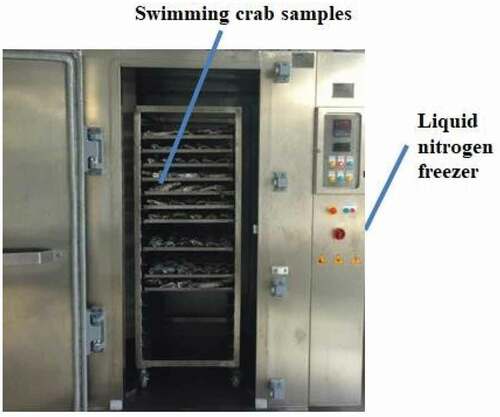
The frozen crab samples were thawed by air thawing (AT, 15°C), refrigerator thawing (RT, 4°C), water immersing thawing (WIT, 15°C), lotic water thawing (LWT, 15°C), and microwave thawing (MT) with a temperature recorder (L93-2 L, Hangzhou Loggertech Co., Ltd, Hangzhou, China) until their core temperature reached 0°C, and the thawing time was recorded. MT was performed in a household microwave oven (EG720FF1-NR, Media Microwave Electronics Co., Ltd., Foshan, China) with a micropower of 700 W. Fresh swimming crab was served as the control.
2.3. Thawing loss measurement
According to the method of Qian et al. (Citation2019), thawing loss was calculated from the weights of the crab samples before and after thawing.
2.4. Determination of thiobarbituric acid-reactive substances (TBARS)
Lipid oxidation of the thawed crab samples was evaluated by TBARS immediately after thawing as described by Maqsood and Benjakul (Citation2010) with some modification. Thawed crab meat (0.5 g) was mixed with 2.5 mL of a TBA solution containing 0.375% thiobarbituric acid, 15% trichloroacetic acid, and 0.25 N hydrochloric acid. The mixture was heated in boiling water for 10 min to develop a pink color, cooled with running tap water, and then centrifuged at 3220 g for 30 min at 4°C in a centrifuge (5810 R, Eppendorf AG, Hamburg, Germany). The absorbance of the supernatant was measured at 532 nm. The TBARS value was expressed as mg of malondialdehyde/kg of the sample.
2.5. Determination of total volatile basic nitrogen (TVB-N)
The TVB-N of the sample was measured according to the method of Huang et al. (Citation2019) with some modification. The 20 g of thawed crab meat was placed in a conical flask, dispersed in 100 mL distilled water, and stirred for 30 min. The homogenate was filtered through filter papers. Then, 10 mL filter liquor was transferred to the distiller of semi-micro quantitative nitrogen with the addition of 5 mL 1% (w/v) magnesium oxide suspension. The distillate was collected in a flask containing a 10 mL 2% (w/v) aqueous solution of boric acid and 5 droplets of mixed indicator produced from dissolution of 0.2 g of methyl red and 0.1 g of methylene blue to 100 mL of ethanol. Afterward, the distillation solution was titrated with a 0.01 mol/L hydrochloric acid solution. The TVB-N value was determined by the hydrochloric acid used during titration and the average value was taken from a total of three measurements.
2.6. Sensory analysis
The sensory evaluation of swimming crab subjected to different thawing methods was carried out according to the method of Lorentzen et al. (Citation2016) with slight modification. Ten trained panelists were invited to score the sensory index, including odor, taste, appearance, discoloration, chewiness, and juiciness of crab meat. All samples were steamed for 15 min previous to sensory analysis. The judges were not informed about the experimental approach and the samples were blind-coded with 3-digit random numbers. A 9-point hedonic scale, ranging from extremely acceptable (9) to extremely unacceptable (1) was utilized for evaluation. Samples receiving overall scores of more than 5 were considered acceptable.
2.7. Texture analysis
After steaming, the swimming crab samples were placed at room temperature (25°C) for 0.5 h to eliminate the influence of high temperature. The crab leg meat closest to the claw was selected and cut into 5 mm pieces. The texture (hardness, springiness, and chewiness) of the swimming crab was measured by the texture analyzer (CT3, Brookfield, USA) and TA 50 cylindrical probe (5 mm) according to the method (Cao et al., Citation2020) after some modification. The measurement speed was 1 mm/s, compression ratio was 30%, and the trigger point load was 5 g.
2.8. Light microscope observation
For histology, swimming crab muscle tissues were fixed in Bouin’s fixative for 24 h and then dehydrated through a graded ethanol series. Samples were embedded in paraffin and sectioned at 5 μm. Paraffin sections were stained with hematoxylin and eosin (H&E) (Wang et al., Citation2017). Then, all samples were examined under a light microscope (Olympus CX31, Olympus Corporation, Tokyo, Japan).
2.9. Statistical analysis
All experiments were done in triplicate unless otherwise specified and the values were expressed as means ± standard deviation (SD) for three different experiments. Statistical significance was determined by one-way analysis of variance. P < 0.05 was considered statistically significant.
3. Results and discussion
3.1. Effect of thawing on thawing time
The results of thawing methods on the thawing time of frozen swimming crab samples are shown in (). MT exhibited the shortest thawing time (5 min) followed by LWT (69 min), WIT (101 min), AT (270 min), and RT (785 min). These discrepancies among the samples may be due to the differences in heat transfer rates exposed to microwave, water, air convection, and low-temperature refrigeration thawing (Choi et al., Citation2017). MT significantly reduced thawing time (P < 0.05) probably by generating heat and exciting water molecules (Arocas et al., Citation2011). Nevertheless, MT may cause temperature unevenness and localized overheating due to the penetration depth of the microwave (Cai et al., Citation2020), especially for the swimming crab with a thick shell. Some parts on the surface of the crab sample turned red and became partially cooked during microwave thawing, especially crab legs. The lesser thawing time obtained by WIT than those by AT under the same ambient temperature can be explained by the characteristic higher thermal conductivity of water compared to air (Lorentzen et al., Citation2019). LWT was more efficient than WIT with shorter thawing time due to the higher heat exchange efficiency of lotic water (Leung et al., Citation2007), while it may cause serious water waste. Although RT and AT had longer thawing time, the air thawing method is quite common in the food industry as well as in the home, because it is economical and does not require a special facility or equipment regardless of the shape or size of the samples (Alizadeh et al., Citation2007).
Figure 2. The effects of thawing treatments on thawing time of frozen swimming crab samples. Different small letters (a, b, c, d, e) in the same line indicate significant differences (P < 0.05) of thawing. AT, air thawing; RT, refrigerator thawing; WIT, water immersing thawing; LWT, lotic water thawing; MT, microwave thawing.
Figura 2. Efectos de los tratamientos de descongelación en el tiempo de descongelación de las muestras de cangrejo Portunus trituberculatus congelado. Las distintas letras minúsculas (a, b, c, d, e) en la misma línea indican diferencias significativas (P < 0.05) de descongelación. AT, descongelación por aire; RT, descongelación por refrigerador; WIT, descongelación por inmersión en agua; LWT, descongelación por agua lótica; MT, descongelación por microondas
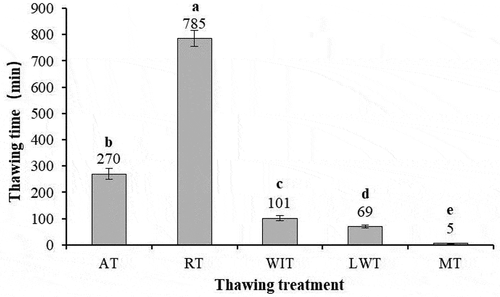
3.2. Effect of thawing on thawing loss
Thawing loss is one of the important indexes of frozen food that affects the product quality and results in economic losses (Hong et al., Citation2013). The results of thawing methods on thawing loss of frozen crab samples are shown in (). Different thawing methods had significant effects on the thawing loss of frozen crabs. The highest thawing loss was recorded for crab samples treated with MT (2.70%) followed by AT (2.22%), WIT (1.97%), and LWT (1.52%), while RT had the lowest thawing loss (1.06%). The frozen crabs were not homogeneous, thus temperature unevenness and localized overheating may occur during microwave treatment, resulting in the high thawing loss from the MT sample. These results were consistent with the report of Jul (Citation1984), which indicated that a slow thawing process in low-temperature environment was preferable because it allowed time for diffusion to take place in the thawed tissue and the water might return to its original positions in the tissue, and also found that microwave thawing resulted in high drip loss due to the quick rate of water vaporization by rapid heating of tiger shrimps. Chandirasekaran and Thulas (Citation2010) also found that microwave treatment samples had the most drip loss. LWT had lower thawing loss than WIT and AT due to the relatively rapid thawing rate at low temperatures, which may be helpful to prevent the loss of product quality (S. Zhu et al., Citation2004).
Figure 3. The effects of thawing treatments on thawing loss of frozen swimming crab samples. Different small letters (a, b, c, d) in the same line indicate significant differences (P < 0.05) of thawing. AT, air thawing; RT, refrigerator thawing; WIT, water immersing thawing; LWT, lotic water thawing; MT, microwave thawing.
Figura 3. Efectos de los tratamientos de descongelación en la pérdida de descongelación de las muestras de cangrejo Portunus trituberculatus congelado. Las distintas letras minúsculas (a, b, c, d) en la misma línea indican diferencias significativas (P < 0.05) de descongelación. AT, descongelación por aire; RT, descongelación por refrigerador; WIT, descongelación por inmersión en agua; LWT, descongelación por agua lótica; MT, descongelación por microondas
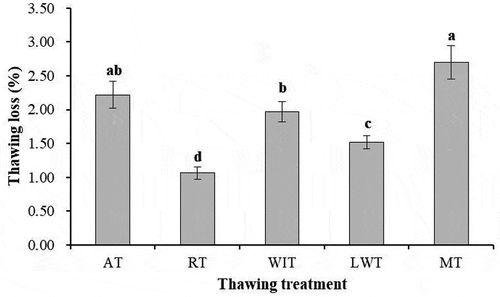
3.3. Effect of thawing on TBARS
The effects of the various thawing treatments on TBARS of frozen crab samples are shown in (). Thawing could cause the autooxidation of polyunsaturated fats (Cheng et al., Citation2019); thus, the thawing treatment had a great influence on TBARS. Compared to the control (fresh swimming crab meat), the TBARS for all the thawing treatments increased significantly (P < 0.05). The TBARS value for RT sample (0.34 mg/kg) was closer to that for the control (0.28 mg/kg), while MT had the highest TBARS (0.66 mg/kg). These results are similar to the study of Boonsumrej et al. (Citation2007), which showed that MT might activate the lipid oxidation in the shrimps and thus gave a higher TBARS value than those thawed in the refrigerator. Low-temperature thawing can reduce the oxidation rate. In addition, the TBARS values for AT (0.51 mg/kg), WIT (0.42 mg/kg), and LWT sample (0.40 mg/kg) were closer to each other, while relative higher TBARS value was measured for AT sample, which may be due to the relatively longer thawing time of AT sample exposure to the air at 15°C than the others.
Figure 4. The effects of thawing treatments on TBARS of frozen swimming crab samples. Different small letters (a, b, c, d, e) in the same line indicate significant differences (P < 0.05) of thawing. Control, fresh meat; AT, air thawing; RT, refrigerator thawing; WIT, water immersing thawing; LWT, lotic water thawing; MT, microwave thawing.
Figura 4. Efectos de los tratamientos de descongelación en los TBARS de muestras de cangrejo Portunus trituberculatus congelado. Las distintas letras minúsculas (a, b, c, d, e) en la misma línea indican diferencias significativas (P < 0.05) de descongelación. Control, carne fresca; AT, descongelación por aire; RT, descongelación en refrigerador; WIT, descongelación por inmersión en agua; LWT, descongelación por agua lótica; MT, descongelación por microondas
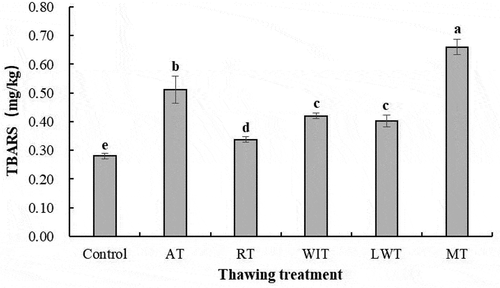
3.4. Effect of thawing on TVB-N
TVB-N, an important index of freshness, is an alkaline nitrogen-containing substance produced by protein decomposition due to enzymatic degradation and microbial action during the spoilage of animal-based foods (Y. Li et al., Citation2019b). Here, the influences of thawing methods on the TVB-N were investigated (). The TVB-N value for the control was 6.67 mg/100 g and no significant differences were observed among the samples after the five different thawing treatments. The LWT and RT samples had lower TVB-N value closer to the control. Relative higher TVB-N values were measured for the samples thawed by WIT (7.53 mg/100 g) and AT (8.12 mg/100 g). According to Citationthe Chinese National Standard (GB 2733–2015) (2015), the highest acceptable TVB-N value for sea crab was 25 mg/100 g. Accordingly, TVB-N values for all these samples were lower than 15 mg/100 g, which indicated that a high standard of freshness was maintained after thawing with these methods.
Figure 5. The effects of thawing treatments on TVB-N of frozen swimming crab samples. Different small letters (a, b) in the same line indicate significant differences (P < 0.05) of thawing. Control, fresh meat; AT, air thawing; RT, refrigerator thawing; WIT, water immersing thawing; LWT, lotic water thawing; MT, microwave thawing.
Figura 5. Ecisma línea indican diferencias significativas (P < 0.05) de descongelación. Control, carne fresca; AT, descongelación por aire; RT, descongelación en el refrigerador; WIT, descongelación por inmersión en agua; LWT, descongelación por agua lótica; MT, descongelación por microondas
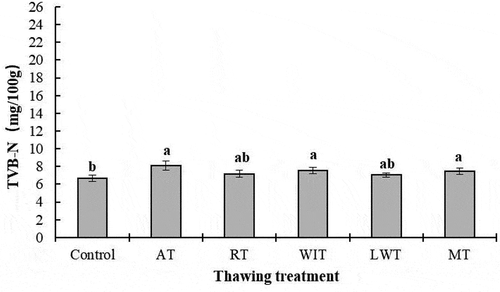
3.5. Effect of thawing on sensory scores
Effects of thawing treatments on sensory scores of swimming crab samples were also evaluated and the results are shown in (). Compared to the control, the sensory scores for AT, RT, WIT, LWT, and MT samples decreased by 10.5%, 4.5%, 9.5%, 6.0%, and 13.0%, respectively. MT sample had the lowest sensory score, which may be due to the water loss and lipid oxidation at a higher temperature during the microwave process. As described by Huff-Lonergan and Lonergan (Citation2005), water loss affected meat product weight, sensory properties, and appearance. The sensory score for the RT sample at a lower temperature was closer to that for the control followed by LWT. These findings were consistent with those changes in thawing loss and TBARS. In terms of appearance, some parts on the surface of the crab legs turned red during microwave thawing, and no significant differences in swimming crab meat color were found between these thawing methods. In terms of texture quality evaluation, changes in filamentous texture will greatly affect the satisfaction of commercial consumption of frozen swimming crab. The crab meat of RT after steaming was found to have relatively distinct filamentous texture similar to the control in our experiment, while the other thawing methods had a certain degree of deterioration in the texture quality, and MT had more serious deterioration. It is indicated that freezing and thawing processes may influence the muscular structure of swimming crab samples, which is mainly related to the formation of ice crystals and the denaturation of proteins (Benjakul et al., Citation2003).
Figure 6. The effects of thawing treatments on sensory scores of frozen swimming crab samples. Different small letters (a, b) in the same line indicate significant differences (P < 0.05) of thawing. Control, fresh meat; AT, air thawing; RT, refrigerator thawing; WIT, water immersing thawing; LWT, lotic water thawing; MT, microwave thawing.
Figura 6. Efectos de los tratamientos de descongelación en las puntuaciones sensoriales de las muestras de cangrejo Portunus trituberculatus congelado. Las distintas letras minúsculas (a, b) en la misma línea indican diferencias significativas (P < 0.05) de descongelación. Control, carne fresca; AT, descongelación por aire; RT, descongelación en refrigerador; WIT, descongelación por inmersión en agua; LWT, descongelación por agua lótica; MT, descongelación por microondas
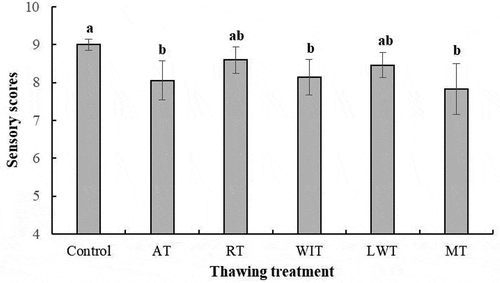
3.6. Effect of thawing on texture properties
In our study, hardness, springiness, and chewiness were used as indexes to evaluate texture characteristics as shown in (). Compared to the control, all thawed samples had a certain degree of decline in hardness, springiness, and chewiness. The hardness, springiness, and chewiness of RT sample were closer to those for the control, while those of the MT sample declined significantly (P < 0.05). These findings were consistent with those changes in TBARS and thawing loss. As described by X. F. Xia et al. (Citation2012), oxidation of myofibrillar protein during the thawing process had a significant effect on the texture of the meat. Liu et al. (Citation2013) also reported that deterioration of meat texture has been related to various internal and external factors, including muscle water loss and tissue degradation. Texture, an important property of muscle protein, is also closely related to the sensory quality of muscle products (W. Xia et al., Citation2018). It can be seen that RT at low temperature may keep the texture characteristics of frozen swimming crab, which is concerned with the excellent taste of distinct filamentous texture as shown by sensory analysis.
Table 1. The effects of thawing on texture characteristics of thawed samples.
Tabla 1. Efectos de la descongelación en las características de textura de las muestras descongeladas
3.7. Effect of thawing on the microstructure
The results of the histological examination of the fresh and thawed swimming crab muscle tissues after different thawing treatments are shown in (). It could be seen that different degrees of gaps were observed between the muscle fibers of swimming crabs after all these thawing processes, which may be because of the mechanical damage to the muscle tissues during thawing processes (Boonsumrej et al., Citation2007). For the control, the muscle fibers were compact and neat, and no obvious gaps were observed between the fibers. Among these thawing methods, RT had the least negative role on the microstructure of crab with tight muscle fibers and minimum gaps between the fibers similar to that of fresh crab meat, which may be due to the small changes in ambient temperature for RT treatment so that the temperature difference of different parts of crab meat is relatively small with slow melting of ice crystals. However, MT induced obviously larger gaps between muscle fibers and broken more muscle fiber bundles. Besides, compared to that observed following LWT treatment, the muscle fibers showed more disordered arrangement and the gaps between muscle fibers significantly increased after AT and WIT, which is probably because of relatively longer thawing time with a large temperature difference between inside and outside of the samples. Overall, RT was apparently more suitable for maintaining the quality of frozen swimming crab meat.
Figure 7. Light micrographs of frozen swimming crab samples under different thawing treatments. Control, fresh meat; AT, air thawing; RT, refrigerator thawing; WIT, water immersing thawing; LWT, lotic water thawing; MT, microwave thawing. Magnification was ×40 and the scale bar indicates 20 μm.
Figura 7. Micrografías de luz de muestras de cangrejo Portunus trituberculatus congelado bajo diferentes tratamientos de descongelación. Control, carne fresca; AT, descongelación por aire; RT, descongelación en refrigerador; WIT, descongelación por inmersión en agua; LWT, descongelación por agua lótica; MT, descongelación por microondas. El aumento fue de ×40 y la barra de la escala indica 20 μm
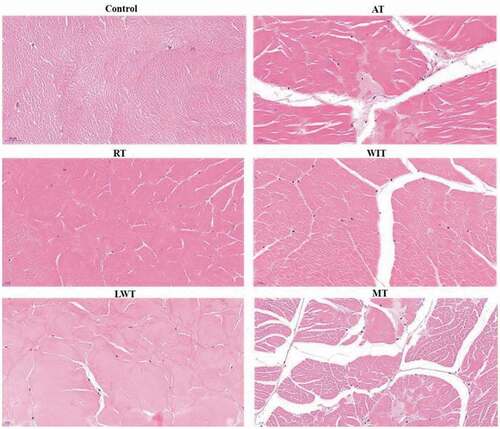
4. Conclusion
In this study, the effects of AT, RT, WIT, LWT, and MT on the quality changes of swimming crab by liquid nitrogen quick freezing were evaluated. The results showed that MT exhibited the highest thawing loss followed by AT, WIT, and LWT, while RT had the lowest thawing loss. RT sample had the lowest TBARS value (0.34 mg/kg) closer to that for the control (0.28 mg/kg), while MT sample had the highest TBARS (0.66 mg/kg). No significant differences in TVB-N were observed among the samples after the five different thawing treatments. Sensory score and texture parameters for the MT sample declined significantly, while the values for the RT sample were closer to those for the control followed by LWT. Besides, MT induced obviously larger gaps between muscle fibers and broken more muscle fiber bundles. RT had the least negative role on the microstructure of crab with tight muscle fibers and minimum gaps between the fibers similar to that of fresh meat. It is indicated that RT had a less detrimental impact on the swimming crab quality in terms of thawing loss, TBARS, sensory scores, texture characteristics, and microstructure compared to the other thawing methods. In conclusion, the results of this study showed that RT was found to be a suitable method to maintain overall quality for swimming crab by liquid nitrogen freezing, and could provide important theoretical reference for the further processing or consumption of frozen swimming crab.
Disclosure statement
All authors declared that there is no conflict of interest in this work.
Additional information
Funding
References
- Alizadeh, E., Chapleau, N., De Lamballerie, M., & Lebail, A. (2007). Effects of freezing and thawing processes on the quality of Atlantic salmon (Salmo salar) fillets. Journal of Food Science, 72(5), E279–E284. https://doi.org/https://doi.org/10.1111/j.1750-3841.2007.00355.x
- Alvarenga, T. I. R. C., Hopkins, D. L., Ramos, E. M., Almeida, A. K., & Geesink, G. (2019, July). Ageing-freezing/thaw process affects blooming time and myoglobin forms of lamb meat during retail display. Meat Science, 153, 19–25. https://doi.org/https://doi.org/10.1016/j.meatsci.2019.02.016
- Anderson, B. A., Sun, S., Erdogdu, F., & Singh, R. P. (2004). Thawing and freezing of selected meat products in household refrigerators. International Journal of Refrigeration, 27(1), 63–72. https://doi.org/https://doi.org/10.1016/S0140-7007(03)00093-8
- Arocas, A., Sanz, T., Hernandob, M., & Fiszman., S. M. (2011). Comparing microwave- and water bath-thawed starch-based sauces: Infrared thermography, rheology and microstructure. Food Hydrocollids, 25(6), 1554–1562. https://doi.org/https://doi.org/10.1016/j.foodhyd.2011.01.013
- Benjakul, S., Visessanguan, W., Thongkaew, C., & Tanaka, M. (2003). Comparative study on physicochemical changes of muscle proteins from some tropical fish during frozen storage. Food Research International, 36(8), 787–795. https://doi.org/https://doi.org/10.1016/S0963-9969(03)00073-5
- Boonsumrej, S., Chaiwanichsiri, S., Tantratian, S., Suzuki, T., & Takai, R. (2007). Effects of freezing and thawing on the quality changes of tiger shrimp (Penaeus monodon) frozen by air-blast and cryogenic freezing. Journal of Food Engineering, 80(1), 292–299. https://doi.org/https://doi.org/10.1016/j.jfoodeng.2006.04.059
- Cai, L., Zhang, W., Cao, A., & Cao, M. (2020, February). Effects of different thawing methods on the quality of largemouth bass (Micropterus salmonides). LWT-Food Science and Technology, 120, 108908. https://doi.org/https://doi.org/10.1016/j.lwt.2019.108908
- Calderara, M., Deorsola, F. A., Bensaid, S., Fino, D., Russo, N., & Geobaldo, F. (2016). Role of ice structuring proteins on freezing-thawing cycles of pasta sauces. Journal of Food Science and Technology, 53(12), 4216–4223. https://doi.org/https://doi.org/10.1007/s13197-016-2409-3
- Cao, J., Wang, Q., Ma, T., Bao, K., Yu, X., Duan, Z., Shen, X., & Li, C. (2020, February). Effect of EGCG-gelatin biofilm on the quality and microbial composition of tilapia fillets during chilled storage. Food Chemistry, 305, 125454. https://doi.org/https://doi.org/10.1016/j.foodchem.2019.125454
- Chandirasekaran, V., & Thulas, G. (2010). Effect of different thawing methods on physico-chemical characteristics of frozen buffalo meat. Journal of Food Technology, 8(6), 239–242. https://doi.org/https://doi.org/10.3923/jftech.2010.239.242
- Cheng, W., Sørensen, K. M., Engelsen, S. B., Sun, D. W., & Pu, H. (2019, December). Lipid oxidation degree of pork meat during frozen storage investigated by near-infrared hyperspectral imaging: Relationship between thiobarbituric acid reactive substances value and ice crystal growth and distribution. Journal of Food Engineering, 263, 311–319. https://doi.org/https://doi.org/10.1016/j.jfoodeng.2019.07.013
- Chinese National Standard (GB 2733–2015). (2015). Hygienic standard for fresh and frozen marine products of animal origin. Chinese National Hygiene Ministry.
- Choi, E. J., Park, H. W., Chung, Y. B., Park, S. H., Kim, J. S., & Chun, H. H. (2017, February). Effect of tempering methods on quality changes of pork loin frozen by cryogenic immersion. Meat Science, 124, 69–76. https://doi.org/https://doi.org/10.1016/j.meatsci.2016.11.003
- Hong, H., Luo, Y. K., Zhou, Z. Y., Bao, Y. L., Lu, H., & Shen, H. X. (2013). Effects of different freezing treatments on the biogenic amine and quality changes of bighead carp (Aristichthys nobilis) heads during ice storage. Food Chemistry, 138(2–3), 1476–1482. https://doi.org/https://doi.org/10.1016/j.foodchem.2012.11.031
- Huang, S., Xiong, Y., Zou, Y., Dong, Q., Ding, F., Liu, X., & Li, H. (2019, May). A novel colorimetric indicator based on agar incorporated with Arnebia euchroma root extracts for monitoring fish freshness. Food Hydrocollids, 90, 198–205. https://doi.org/https://doi.org/10.1016/j.foodhyd.2018.12.009
- Huff-Lonergan, E., & Lonergan, S. M. (2005). Mechanisms of water-holding capacity of meat: Mechanisms of water-holding capacity of meat: The role of post-mortem biochemical and structural changes. Meat Science, 71(1), 194–204. https://doi.org/https://doi.org/10.1016/j.meatsci.2005.04.022
- Jia, G. L., Sha, K., Meng, J., & Liu, H. J. (2019). Effect of high voltage electrostatic field treatment on thawing characteristics and post-thawing quality of lightly salted, frozen pork tenderloin. LWT-Food Science and Technology, 99, 268–275. https://doi.org/https://doi.org/10.1016/j.lwt.2018.09.064
- Jul, M. (1984). The quality of frozen foods. Academic Press.
- Leung, M., Ching, W. H., Leung, D. Y. C., & Lam, G. C. K. (2007). Fluid dynamics and heat transfer in cold water thawing. Journal of Food Engineering, 78(4), 1221–1227. https://doi.org/https://doi.org/10.1016/j.jfoodeng.2005.10.042
- Li, D. M., Zhu, Z. W., & Sun, D.-W. (2018, May). Effects of freezing on cell structure of fresh cellular food materials: A review. Trends in Food Science & Technology, 75, 46–55. https://doi.org/https://doi.org/10.1016/j.tifs.2018.02.019
- Li, F. F., Wang, B., Liu, Q., Chen, Q., Zhang, H. W., Xia, X. F., & Kong, B. (2019a). Changes in myofibrillar protein gel quality of porcine longissimus muscle induced by its structural modification under different thawing methods. Meat Science, 147, 108–115. https://doi.org/https://doi.org/10.1016/j.meatsci.2018.09.003
- Li, Y., Tang, X., Shen, Z., & Dong, J. (2019b, July). Prediction of total volatile basic nitrogen (TVB-N) content of chilled beef for freshness evaluation by using viscoelasticity based on airflow and laser technique. Food Chemistry, 287, 126–132. https://doi.org/https://doi.org/10.1016/j.foodchem.2019.01.213
- Liu, D. S., Liang, L., Xia, W. S., Regenstein, J. M., & Zhou, P. (2013). Biochemical and physical changes of grass carp (Ctenopharyngodon idella) fillets stored at −3 and 0°C. Food Chemistry, 140(1–2), 105–114. https://doi.org/https://doi.org/10.1016/j.foodchem.2013.02.034
- Lorentzen, G., Lian, F., Røhme, A. A., Johannessen, E., Grastveit, K. V., Grip, A. E., & Siikavuopio, S. I. (2019, July). Effect of freezing-thawing on weight loss, melanosis, and microbial growth in mildly cooked snow crab (Chionoecetes opilio) clusters. LWT-Food Science and Technology, 108, 283–288. https://doi.org/https://doi.org/10.1016/j.lwt.2019.03.083
- Lorentzen, G., Rotabakk, B., Olsen, S., Skuland, A., & Siikavuopio, S. (2016, January). Shelf life of snow crab clusters (Chionoecetes opilio) stored at 0 and 4 °C. Food Control, 59, 454–460. https://doi.org/https://doi.org/10.1016/j.foodcont.2015.06.019
- Maqsood, S., & Benjakul, S. (2010). Comparative studies of four different phenolic compounds on in vitro antioxidative activity and the preventive effect on lipid oxidation of fish oil emulsion and fish mince. Food Chemistry, 119(1), 123–132. https://doi.org/https://doi.org/10.1016/j.foodchem.2009.06.004
- Miao, W., Hatab, S., Gu, Y., Wang, L., Xu, X., & Pan, S. (2018). Rheological, sensory, and microstructural properties of fresh and frozen/thawed mashed potatoes enriched with different proteins. CyTA - Journal of Food, 16(1), 113–121. https://doi.org/https://doi.org/10.1080/19476337.2017.1345982
- Palazoğlu, T. K., & Miran, W. (2017, June). Experimental comparison of microwave and radio frequency tempering of frozen block of shrimp. Innovative Food Science & Emerging Technologies, 41, 292–300. https://doi.org/https://doi.org/10.1016/j.ifset.2017.04.005
- Qian, S. Y., Li, X., Wang, H., Mehmood, W., Zhong, M., Zhang, C. H., & Blecker, C. (2019). Effects of low voltage electrostatic field thawing on the changes in physicochemical properties of myofibrillar proteins of bovine longissimus dorsi muscle. Journal of Food Engineering, 261, 140–149. https://doi.org/https://doi.org/10.1016/j.jfoodeng.2019.06.013
- Sun, B., Zhao, Y., Ling, J., Yu, J., Shang, H., & Liu, Z. (2017). The effects of superchilling with modified atmosphere packaging on the physicochemical properties and shelf life of swimming crab. Journal of Food Science and Technology, 54(7), 1809–1817. https://doi.org/https://doi.org/10.1007/s13197-017-2611-y
- Wang, Y., Li, X., Fu, G., Zhao, S., Chen, Y., Wang, H., Chen, T., Zhou, J., & Fang, W. (2017). Morphology and phylogeny of Ameson portunus n. sp. (Microsporidia) infecting the swimming crab Portunus trituberculatus from China. European Journal of Protistology, 61(Part A), 122–136. https://doi.org/https://doi.org/10.1016/j.ejop.2017.09.008
- Wu, X.-F., Zhang, M., Adhikari, B., & Sun, J. C. (2017). Recent developments in novel freezing and thawing technologies applied to foods. Critical Reviews in Food Science and Nutrition, 57(17), 3620–3631. https://doi.org/https://doi.org/10.1080/10408398.2015.1132670
- Xia, W., Ma, L., Chen, X., Li, X., & Zhang, Y. (2018, September). Physicochemical and structural properties of composite gels prepared with myofibrillar protein and lecithin at various ionic strengths. Food Hydrocolloids, 82, 135–143. https://doi.org/https://doi.org/10.1016/j.foodhyd.2018.03.044
- Xia, X. F., Kong, B. H., Liu, J., Diao, X. P., & Liu, Q. (2012). Influence of different thawing methods on physicochemical changes and protein oxidation of porcine longissimus muscle. LWT-Food Science and Technology, 46(1), 280–286. https://doi.org/https://doi.org/10.1016/j.lwt.2011.09.018
- Xu, Z. Q., Guo, Y. H., Ding, S. H., An, K. J., & Wang, Z. F. (2014, April). Freezing by immersion in liquid CO2 at variable pressure response surface analysis of the application to carrot slices freezing. Innovative Food Science & Emerging Technologies, 22, 167–174. https://doi.org/https://doi.org/10.1016/j.ifset.2013.06.005
- Yuan, Y., Wang, X., Jin, M., Jiao, L., Sun, P., Betancor, M., Tocher, D., & Zhou, C. (2020, March). Modification of nutritional values and flavor qualities of muscle of swimming crab (Portunus trituberculatus): Application of a dietary lipid nutrition strategy. Food Chemistry, 308, 125607. https://doi.org/https://doi.org/10.1016/j.foodchem.2019.125607
- Zhu, S., Ramaswamy, H. S., & Simpson, B. K. (2004). Effect of high-pressure versus conventional thawing on color, drip loss and texture of Atlantic salmon frozen by different methods. LWT-Food Science and Technology, 37(3), 291–299. https://doi.org/https://doi.org/10.1016/j.lwt.2003.09.004
- Zhu, Z., Luo, W., & Sun, D. (2020, February). Effects of liquid nitrogen quick freezing on polyphenol oxidase and peroxide activities, cell water states and epidermal microstructure of wolfberry. LWT-Food Science and Technology, 120, 108923. https://doi.org/https://doi.org/10.1016/j.lwt.2019.108923
